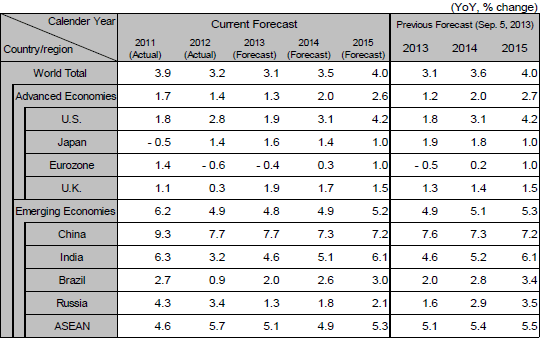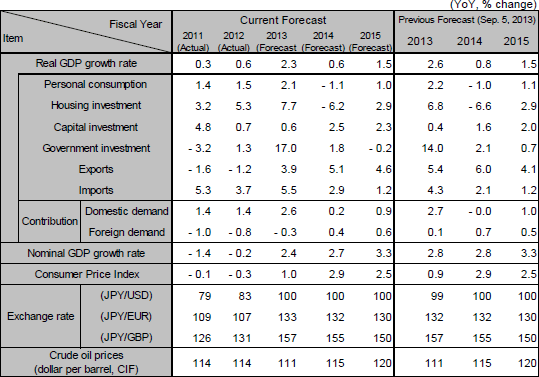Latest economic forecasts for Japan, the U.S., Europe, and China, etc
The forecast for the real GDP growth rate for the world economy for 2014 is 3.6%, which is the same as the previous forecast, and exceeds the 3.1% for 2013. The forecast for the real GDP growth rate for the economy of advanced countries is 2.0% while the economies of Japan and the U.S. are steadily recovering. Meanwhile, the real GDP growth rate for the economy of emerging countries is expected to be 5.0%, which is 0.1% downward revision of the previous forecast. In countries such as India, Brazil, South Africa, Turkey, Indonesia, and Thailand, the unclear political situation weakened the value of the currency, and therefore the forecast for these countries was downwardly revised. 7.3% for China remains unchanged.
For the U.S., the forecast is 3.1% growth for 2014, and the economic recovery is expected to accelerate. Concerns surrounding the shutdown of the federal government and the U.S. debt default from January to February 2014 were not realized. From October to December 2013, the annualized growth rate from the previous quarter is 3.2% which shows the economy is stable. For January to March 2014, a slight deceleration is expected due to the wave of cold weather. However, an acceleration of growth is expected in April to June 2014 and beyond. In response to the steady economic recovery, the FRB decided to taper (asset purchase reduction) QE3 (third round of quantitative easing) in meetings in December 2013 and January 2014. However, new FRB Chair Yellen, who took office in February 2014, intends to continue with the zero interest rate and monetary easing will continue. In fiscal policy side, the amount of sequestration was reduced from the previous year. Monetary and fiscal policy will boost the economy of 2014.
In the eurozone, the real GDP growth rate for 2014 will be 0.3%, and as the entire eurozone, the eurozone will break away from negative growth for the first time in the past 3 years. However, in southern European countries, prolonged economic stagnation is expected. In October to December 2013, there was positive growth for 3 consecutive quarters (annualized growth rate from the previous quarter of 1.1%). Driven by Germany, the economy seems to have bottomed out in the entire eurozone. However, if we look at the economic situation by country, the economies of Spain and Italy have not yet recovered though they are finally showing signs of bottom-out. Against an inflation target of below but close to 2%, inflation rates are hovering below 1% in these countries, thereby generating deflation concerns. Even in this background, the ECB deferred additional measures in a meeting of the Governing Council held on February 6, 2014. Thus, monetary easing is slightly lagging behind, and the stagnation of southern European countries is expected to be prolonged.
In China, the real GDP growth rates will slow from 7.7% in 2013 to 7.3% in 2014. Production related indices, such as growth rates for the power consumption volume and volume of rail freight transportation and manufacturing PMI, declined toward the end of 2013, which indicates a deceleration of the economy. Financing was slightly tightened to control the real estate bubble and shadow banking, and housing prices showed signs of peaking at the end of 2013. However, due to efforts to avoid a bursting of the bubble economy, China is also taking stopgap measures such as the supply of funding just as short-term interest rates rise sharply and relieving “Wealth Management Products” which have a possibility of defaulting. China will continue to walk the tightrope of promoting reform while efforts to prevent a rapid slowdown of the economy will continue.
Currencies of emerging countries such as the Indian rupee and Brazilian real have significantly fallen since May 22, 2013 when FRB Chairman Bernanke (at that time) implied a taper-off of QE3. Although these currencies have began to stabilize since September due to currency protection measures including a raise in interest rates by each central bank, the Argentine peso sharply declined on January 22, 2014 which in turn triggered another decline of these currencies. As of the middle of February, the currencies have stabilized again at a lower level than before, however, market psychology tends to avoid risk, and the possibility of further destabilization if a shock such as a rapid deceleration of Chinese economy occurs cannot be ruled out.
The real GDP growth rate for the Japanese economy is 1.0% in October to December 2013 which is 4 consecutive quarters of positive growth. The Consumer Price Index exceeds the previous year for 7 consecutive months as of December 2013, and the Japanese economy is departing from deflation. As a result, the real interest rate is -1.7% as of February 13, 2014 which is greatly negative. Partly due to last-minute demand prior to the raise of the consumption tax rate (from 5% to 8%) from April 1, 2014, personal consumption, housing investment, and capital investment increased. Imports increased according to the increase of domestic demand while exports slowed partly due to the impact from the slowdown of the economies of emerging countries, and net foreign demand contributed on the minus side for 2 consecutive quarters.
The approximately 5.5 trillion supplementary budget for the fiscal year 2013 where the economic policy package is executed came into effect on February 14, 2014. Due in part to such underlying support, the growth rate of fiscal year 2014 will be 0.6% and economic recovery is forecast to continue.

Note: Since the figures above are based on the calendar year, the figures for Japan are different from the fiscal-year based figures in the table below.
Source: IMF. Forecast by Hitachi Research Institute

Source: National Accounts, etc. Forecast by Hitachi Research Institute.